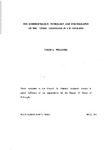THE SEDIMENTOLOGY, PETROLOGY AND STRATIGRAPHY OF THE UPPER GREENSAND IN S.W. ENGLAND
| dc.contributor.author | WILLIAMS, COLIN L. | |
| dc.contributor.other | School of Geography, Earth and Environmental Sciences | en_US |
| dc.date.accessioned | 2013-10-09T09:37:42Z | |
| dc.date.available | 2013-10-09T09:37:42Z | |
| dc.date.issued | 1991 | |
| dc.identifier | NOT AVAILABLE | en_US |
| dc.identifier.uri | http://hdl.handle.net/10026.1/2101 | |
| dc.description.abstract |
A new lithostratigraphic scheme is proposed for those deposits formerly known as the Upper Greensand. In the south and south-west of England the proposed Selbome Group is made up of the proposed Wessex Greensand Formation and Gault Clay Formation as well as the existing Haldon Sands Formation. Four members are proposed and type sections are designated. Lithological logs are presented for sections at Branscombe/Beer Head (Type Section for the Foxmould Sands Member and the Chert Beds Member); Kempstone Rocks, Dunscombe, S.E. Devon (Type Section for the Top Sandstones Member); Whitecliff, Seaton, S.E. Devon; and a small quarry at Dunscombe, S.E. Devon. The sediments found in these sections are divided up into 15 fades. Each facies is described in detail including local variations and associations with other facies. An environmental interpretation is suggested for each facies and it is suggested that the upper part of the Wessex Greensand Formation represents a shallowing upwards sequence which was strongly tidal and storm influenced. A series of events leading to the formation of chert within the Chert Beds Member is proposed. The gradual replacement of calcite and glauconite combined with void-fill chalcedony and microquartz rim cements are shown to result in a ghost fabric. A new ammonite occurrence is reported from the Foxmould Sands Member at Branscombe. Identified as Prohystoceras (Goodhallites) delabechei it suggests a varicosum Subzone age for the lower part of the Foxmould Sands Member. 23 genera and 32 species of Foraminifera are described. The smaller Foraminifera suggest that the upper part of the Foxmould Sands Member may be as young as dispar Zone but do not allow any further refinement of the age of the Chert Beds Member. An in depth examination of the occurrence of the large benthonic Foraminiferan Orbitolina in S.W. England allowed the identification of members of the Orbitolina sefini - O. concava plexus. These foraminifera are used to refine the age and correlation of the Selbome Group in S.W. England. 'Orbitolina' occurrences from Wilmington are shown to belong to the sponge genus Porosphaera. The occurrence of both O. sefini and O.sp. cf. concava in S.W. England has allowed the proposal of a colonisation pathway for the Orbitolines from the Iberian Peninsular via the S.W. Approaches to S.W. England rather than by way of the Paris Basin. Using the techniques of sequence stratigraphy a basin history is presented for S.W. England during Albian/Cenomanian times. A sea-level curve is presented and compared with existing curves. | en_US |
| dc.language.iso | en | en_US |
| dc.publisher | University of Plymouth | en_US |
| dc.title | THE SEDIMENTOLOGY, PETROLOGY AND STRATIGRAPHY OF THE UPPER GREENSAND IN S.W. ENGLAND | en_US |
| dc.type | Thesis | |
| plymouth.version | Full version | en_US |
| dc.identifier.doi | http://dx.doi.org/10.24382/1545 | |
| dc.identifier.doi | http://dx.doi.org/10.24382/1545 |
Files in this item
This item appears in the following Collection(s)
-
01 Research Theses Main Collection
Research Theses Main


